 “Then let’s head down into that cellar and carve ourselves a witch.”
“Then let’s head down into that cellar and carve ourselves a witch.”
After the financial and (perceived) artistic failure of CRIMEWAVE, Raimi and company were itching for a win, and knew their best bet was to return to the one that had worked, THE EVIL DEAD. When they couldn’t find financing, their savior was the same guy who arguably made their careers by raving about THE EVIL DEAD: Stephen King. One of the crew members Raimi and friends had interviewed for the potential sequel was working on King’s directorial debut MAXIMUM OVERDRIVE, and happened to mention to King that Raimi was having trouble getting a greenlight. King was like Are you kidding me? There could be an EVIL DEAD part 2 but nobody will let them do it!?, called up his producer Dino De Laurentiis and convinced him to meet with Raimi. So give that man a medal.
De Laurentiis was skeptical of the project, especially after Raimi and friends rejected filming at his Wilmington, North Carolina studio. But he agreed, allowing a $3.6 million budget, small enough to rule out their plans to set it in medieval times, but giving them more to work with than either of their previous films. And the studio gambit worked exactly as intended – the three hour drive to the locations made it harder for higher ups to pull any CRIMEWAVE shit..
When I think of the greatness of EVIL DEAD II (sometimes advertised as EVIL DEAD 2: DEAD BY DAWN), my mind usually goes straight to the kinetic gruesomeness – flying eyeballs and limbs, sawing up zombies and demons, fighting and chasing a possessed hand. But the movie kicks right off with a different type of fun: a fantasy movie style prologue. A narrator tells us about the Necronomicon Ex Mortis a.k.a. Book of the Dead as a stop motion version of it is composited over smoke. The camera flies through its mouth and into a swirling spiral as cackling Pepper’s-ghost-style see-through spirits represent “a passageway to the evil worlds beyond.” This dissolves into a time “when the seas ran red with blood” (red-tinted footage of waves) before an invisible quill fills the animated pages of the book with hieroglyphics and diagrams. Reverse footage of smoke forms into the title and we zoom between the Roman numerals, becoming the point-of-view of Ash’s car driving through a tunnel toward the cabin (veering way over the center line, already endangering himself).
 It strikes me that Francis Ford Coppola brought a similar sense of playful montage graphics in the much more expensive BRAM STOKER’S DRACULA (1992). We could also compare the model and matte painting shots of the bridge to DRACULA’s miniature train. That film is an outlier – this sort of hand-made visual panache has never been common in the modern era. But it was Raimi’s signature style, born from both the old movies he loved and the limitations of his budgets.
It strikes me that Francis Ford Coppola brought a similar sense of playful montage graphics in the much more expensive BRAM STOKER’S DRACULA (1992). We could also compare the model and matte painting shots of the bridge to DRACULA’s miniature train. That film is an outlier – this sort of hand-made visual panache has never been common in the modern era. But it was Raimi’s signature style, born from both the old movies he loved and the limitations of his budgets.
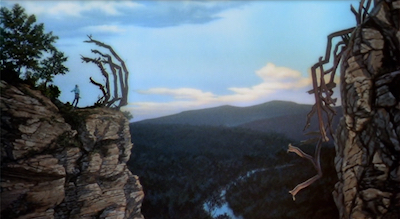 People sometimes say EVIL DEAD II is a remake, but that wasn’t the intent. Raimi wanted to use clips from the first film to set up the premise, but its vast number of international distributors made licensing the footage nearly impossible, so he decided to re-film it instead. The first 7 minutes of the sequel are a streamlined version of the first film, with only Ash and Linda (now played by Denise Bixler, CRISIS IN THE KREMLIN) coming to the cabin. Some details have been reworked: instead of renting a cabin, they’re pulling a Goldilocks move, sneaking in while the owners – Professor Raymond Knowby (John Peakes, THE MIGHTY MACS) and his wife Henrietta (Lou Hancock, MIRACLE MILE, Walker Texas Ranger) – are out of town. Ash plays Knowby’s reel-to-reel and unleashes “a spiritual presence, a thing of evil that roams the forests and the dark bowers of man’s domain.”
People sometimes say EVIL DEAD II is a remake, but that wasn’t the intent. Raimi wanted to use clips from the first film to set up the premise, but its vast number of international distributors made licensing the footage nearly impossible, so he decided to re-film it instead. The first 7 minutes of the sequel are a streamlined version of the first film, with only Ash and Linda (now played by Denise Bixler, CRISIS IN THE KREMLIN) coming to the cabin. Some details have been reworked: instead of renting a cabin, they’re pulling a Goldilocks move, sneaking in while the owners – Professor Raymond Knowby (John Peakes, THE MIGHTY MACS) and his wife Henrietta (Lou Hancock, MIRACLE MILE, Walker Texas Ranger) – are out of town. Ash plays Knowby’s reel-to-reel and unleashes “a spiritual presence, a thing of evil that roams the forests and the dark bowers of man’s domain.”
The sequel’s first shaky-cam-invisible-force-P.O.V. shot rams through a cabin window and shatters it before zooming into Linda’s screaming mouth. Less than a minute later she’s become a white-eyed, sharp-toothed cackling demoness, Ash has whacked her head off with a shovel and buried her, even fashioning her a wooden cross. (I’m not sure how he expects the Knowbys to feel about this monument on their property.)
The next evil-cam (7 minutes in) knocks open the door, flies down the hallway, bulldozes a door, shatters another one and zooms into Ash’s mouth, a re-creation of the first film’s final shot. But this time the shot continues as it carries Ash through the woods, spinning around like he’s attached to a windmill. (In fact they filmed it by bolting him to a cross spinning on a motor on a crane attached to a moving truck.) He falls face-first in a puddle and lays there for a while, as if drowning, before rising and revealing that he’s turned into a possessed ghoul. Luckily the sun is coming up, the fog is sucked out of the air and Ash returns to normal. Close one.
Though so much of this movie moves a mile a minute, here the score (by returning composer Joseph Lo Duca) takes a break and Raimi takes a breath with a 50-second, 360-degree pan from Ash to the trees, the cabin, the car, the grave and back to Ash before he says, “It’s gone.”
In this new chapter, Ash will battle the spirits on his own for a while until the professor’s daughter Annie (Sarah Berry, C.H.U.D. II: BUD THE CHUD), her boyfriend/associate professor Ed (Richard Domeier, TEEN WOLF, DIE HARD 2) and two rednecks who gave them a ride, Jake (Dan Hicks, MANIAC COP, INTRUDER, DARKMAN) and Bobby Joe (Kassie Wesley, WE ARE WHAT WE ARE) show up and make the understandable assumption that this guy covered in blood murdered Annie’s parents.
(Jake and Bobby Joe are definitely redneck stereotypes, but as soon as they’re threatened it doesn’t seem like the movie has a low opinion of them. They work together with the others and try to survive. And after all, it was an academic that unleashed this Pandora’s box in the first place. Also, if Jake hadn’t been there to give Annie a ride, she’d never have gotten to the cabin with her recent archaeological find that will send the evil packing.)
But before all that it’s amazing how many classic sequences Ash can bring us when he’s the only living human on screen. In evil-cam shot #3 the presence chases him through the cabin, breaking through a door, following him through a maze of lefts and rights all through the cabin and falling for a trick where he fakes and darts behind a door. It briefly looks around for him before giving up and returning deep into the woods.
Another highlight is the scene where Linda’s partially skeletonized corpse comes out of the dirt, sashays around, does a little trick where she removes her head and rolls it down her arm. The scene was animated in stop motion by Doug Beswick, whose previous credits included The Gumby Show and STAR WARS and building the Terminator model for THE TERMINATOR. He’d go on to do stop motion for BEETLEJUICE, A NIGHTMARE ON ELM STREET 3: DREAM WARRIORS and CABIN BOY, and he was 3D animation supervisor for BLADE.
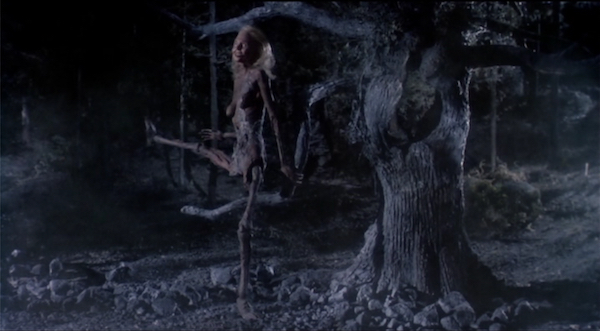
Though most everything else in the movie is live action, there are sequences that play almost like Tom & Jerry shorts from Hell. At least that’s how I think of the one about Ash’s long battle against his own hand. After touching a haunted chair he loses control of it, it taunts him, breaks dishes over his head, even grabs him by the back of the neck and flips him. But we also must give credit to the scene where he’s running around with a rubber head pretending it’s chewing on his hand and he can’t get it off, then gets ambushed by its body waving a chainsaw. To this day, EVIL DEAD II remains a legendary physical performance by the guy they said wasn’t experienced enough to star in CRIMEWAVE.
If there’s one aspect most responsible for EVIL DEAD II’s classic status, it’s fair to say it’s Raimi’s pioneering brand of splatter slapstick. The tone has definitely shifted a little from THE EVIL DEAD to become more jokey. But I’ve always appreciated that it doesn’t lean all the way into comedy – it’s still legitimate horror. Even that hand sequence starts with a very simple bit of creepiness. Seeing a rocking chair moving on its own, Ash slowly approaches it, reaches his hand toward it, and as he gets near it it just stops.
That would be creepy enough, but he starts to feel weird and looks in the mirror to calm himself down. “I’m fine” he whispers to himself. But suddenly his reflection reaches out of the mirror and grabs him. “I don’t think so. We just cut up our girlfriend with a chainsaw. Does that sound fine?” That it starts not as a fancy compositing effect, but just Campbell inside a frame grabbing a double – and that the illusion works! – makes it particularly effective.
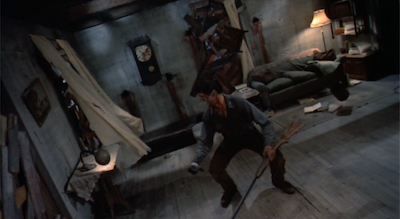 The part where an eyeball pops out of a demon’s skull and lands in Bobby Jo’s screaming mouth (my favorite part for many years) is pretty silly. But another laugh comes from Ash saying “Who’s laughing now?” as he defeats his hand by sawing it off, blood spraying all over his face. And maybe my favorite bit of acting is when all the furniture starts moving around and cackling, and Ash begins to laugh crazily and squat up and down to mimic a living desk lamp. So much of the humor in this movie is pitch black. This guy is losing more than just his hand. 35 minutes in he’s about where Sally gets to at the end of THE TEXAS CHAIN SAW MASSACRE. And then he has to get it together and become the hero.
The part where an eyeball pops out of a demon’s skull and lands in Bobby Jo’s screaming mouth (my favorite part for many years) is pretty silly. But another laugh comes from Ash saying “Who’s laughing now?” as he defeats his hand by sawing it off, blood spraying all over his face. And maybe my favorite bit of acting is when all the furniture starts moving around and cackling, and Ash begins to laugh crazily and squat up and down to mimic a living desk lamp. So much of the humor in this movie is pitch black. This guy is losing more than just his hand. 35 minutes in he’s about where Sally gets to at the end of THE TEXAS CHAIN SAW MASSACRE. And then he has to get it together and become the hero.
When Annie, Ed, Jake and Bobby Joe show up they tackle Ash and lock him in the cellar. I love the knowingly convenient timing of demonic Henrietta (first stop motion, then Ted Raimi in makeup) bursting out of the dirt just after Annie plays the recording of her dad saying, “I buried her in the cellar. God help me I buried her in the earthen floor of the fruit cellar.”
Freed from captivity and proving himself by fighting off the demon, Ash teams with the others to try to survive. They face a couple funhouses worth of supernatural weirdness, both elaborate and elegantly simple. I love the sequence depicting what Ash theorizes is “maybe something trying to force its way into our world” primarily through sound effects, the actors whipping their heads around to look in different directions, and jittery zooms and pans to various objects around the room. Of course the movie is also brimming with blasts of terror as unseen forces rush in to possess people, transform them into weird monsters, make them float and speak in evil voices and attack everybody. “The things that were and shall be again” sure do love to grab people by the face and toss them against walls, ceilings, furniture and trees.
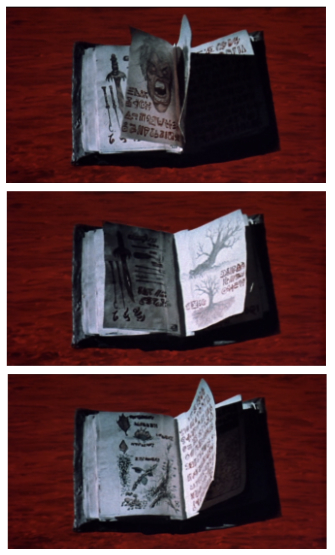 The forest itself is a threat, moving and further isolating the cabin. Stop motion and puppet trees twitch and wiggle on their own, making eerie cracks and creaks. Raimi redoes the first film’s infamous vine attack scene but mercifully it’s no longer a sexual assault, instead becoming a high speed drag through the forest. (Careful use of the pause button when the Necronomicon pages flip by in the opening shows that they foreshadow the importance of plants and daggers and the look of some of the demons.)
The forest itself is a threat, moving and further isolating the cabin. Stop motion and puppet trees twitch and wiggle on their own, making eerie cracks and creaks. Raimi redoes the first film’s infamous vine attack scene but mercifully it’s no longer a sexual assault, instead becoming a high speed drag through the forest. (Careful use of the pause button when the Necronomicon pages flip by in the opening shows that they foreshadow the importance of plants and daggers and the look of some of the demons.)
At this point in his career, Raimi had a joke rivalry going with Wes Craven. Having noticed a torn JAWS poster in Craven’s THE HILLS EYES, Raimi had worked a torn HILLS HAVE EYES poster into THE EVIL DEAD, as if to say “your movie may be scarier than JAWS, but ours is even scarier than yours.” I’m sure at the time they didn’t expect a response from Craven, but they got one in A NIGHTMARE ON ELM STREET, when Nancy dozed off with THE EVIL DEAD showing on TV.
This time Raimi has a Freddy Krueger glove hanging on the wall of the cellar in a few shots. That seems more like an homage than any sort of competitive swipe, but perhaps unintentionally there’s some one-ups-manship in Raimi’s use of not one but two impossible blood geysers rivaling the one coming from Glen’s bed in ELM STREET. First, gallons and gallons of blood blast from a gunshot hole in the wall and into Ash’s face, then the blood turns black and sucks back into the wall. Second, a flood of it explodes from the trap door as Jake is dragged down into the cellar.
About an hour in, Ash gets possessed again, and there’s no sunlight to save him. He runs around roaring with white eyes, and both Jake and Annie fall victim to his special move of lifting a person fully above his head and throwing them against something. Jake doesn’t survive long, and it’s up to Annie to protect herself with the Kandarian dagger (an archaeological treasure crafted from bones) and an ax, and scream as Ash tries to bash his way through the door. I doubt it occurred to me at the time, and of course we can’t imagine it now, but at this point it could’ve followed the established rules of the genre and left Annie as the final girl, the survivor, the Ripley, the hero.
Instead, possessed Ash finds Linda’s necklace, inspiring a memory that reignites his humanity just in time to almost get axed by Annie and have to convince her he’s okay now. Once they’ve agreed they’re on the same team it’s the major turning point in the movie (and series) when he decides to transform himself into a weapon. I think this montage might be the most influential sequence of the movie. It lasts a little under 50 seconds and is made up of 20 shots, most of them in closeup, very short, and rhythmically accompanied by a different sound effect:
Ash’s hand unchaining the door to the shed. Backlit shot from inside as he swings open the door, looking badass.
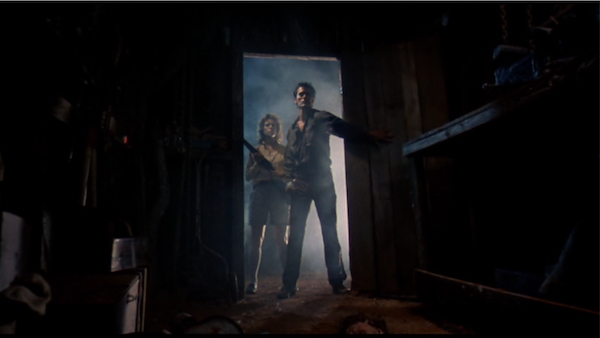
Hand clicking on the hanging light bulb. Rat squeaking and scurrying across a shelf next to some metal scraps and tools. Hand brushing sawdust and nails on the workbench to clear a space. Metal ring clunking onto the bench. Second metal ring. Drill going into chainsaw handle. Soldering something to the chainsaw motor. Closing the chainsaw. Snapping open one of the rings. Screwdriver screwing the ring to the chainsaw. Annie reaching up to some leather straps hanging on the wall. Tightening a strap across Ash’s chest. Ash’s stump inserting into the chainsaw base. Ash attaching the blade to the chainsaw.

Ash lifting and looking at his new chainsaw attachment. Hooking the pullstring to a clasp on his shoulder. Annie observing, almost lustfully, sharply inhaling in anticipation of what he’s about to do.
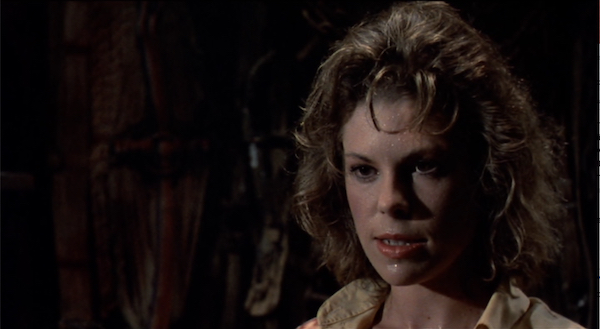
Finally a longer shot as Ash straightens his arm, causing the engine to rev, then lifts his shotgun and saws at its barrel, filling the frame with sparks, snapping the barrel off with his elbow, spinning the newly customized weapon as the camera slowly moves in closer, dropping it in a holster on his back.
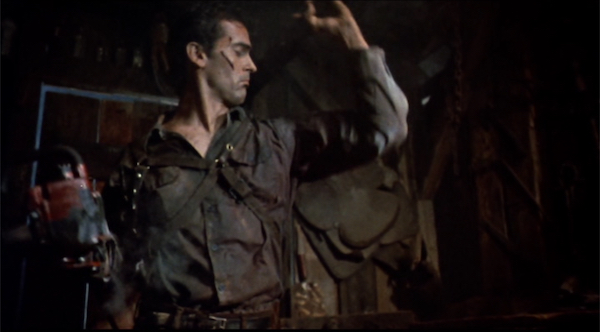
It’s still the same shot but the camera is close on his face when he says, “Groovy.”
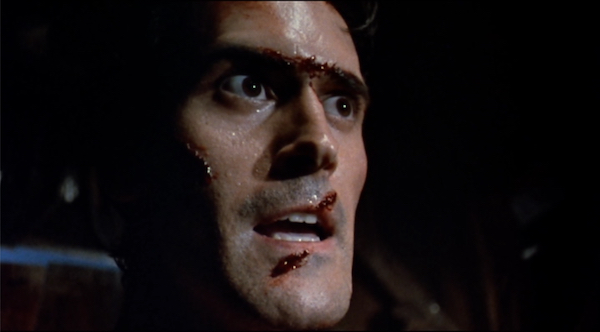
It’s very much a horror take on an action trope, the gearing up sequence. Closeups and sound effects as the heroes strap on their guns and grenades and shit, zip up their bags, load and rack their ammunition, slide knives into holsters, tighten their vests, sometimes customize their weapons like this, though not as cleverly. Good examples that predate EVIL DEAD II include, in chronological order, RAMBO: FIRST BLOOD PART II, COMMANDO, RAW DEAL, and ALIENS, and I’m sure one or more of those inspired this scene. But whenever I see a gearing up scene in a horror comedy I think, “Yeah, we know, you’ve seen EVIL DEAD II.”
The ‘80s action influence also manifests as Ash peppers his stand against the evil dead with a few tough guy one-liners, most notably when he responds to the severed monster head’s squeals of “I’ll swallow your soul!” with a perfectly timed “Swallow this” and explosive shotgun blast. And then he looks so nonchalant as he blows on the barrel, spins the weapon and holsters it again. I don’t think it’s wrong to consider this “tongue in cheek” – it’s intentionally goofy for the scared everyman of the first film to become this swaggering macho man – but I also think these work on the same level as similar lines in, say, the films of Arnold Schwarzenegger. They’re funny and awesome in the same exact way. It’s not making fun of scenes like that, it is a scene like that. The next moments aren’t played for laughs – he comes over and holds Annie as she sobs, since that monster head used to be her mother.
 I’d like to take a moment to honor Annie Knowby. She doesn’t seem to be a very celebrated character among horror fandom, since she’s mostly in the second half, is kind of the straight woman/sidekick to the more showy character of Ash, and did not survive to be in the sequel or TV series. But she does save his ass, and quite possibly the world’s ass. And I think the fact that she doesn’t seem pathetic despite going from believing Ash murdered her parents to holding his arm for comfort in 10 minutes of screen time shows that Berry conveys a strong and capable presence on screen. I respect Annie.
I’d like to take a moment to honor Annie Knowby. She doesn’t seem to be a very celebrated character among horror fandom, since she’s mostly in the second half, is kind of the straight woman/sidekick to the more showy character of Ash, and did not survive to be in the sequel or TV series. But she does save his ass, and quite possibly the world’s ass. And I think the fact that she doesn’t seem pathetic despite going from believing Ash murdered her parents to holding his arm for comfort in 10 minutes of screen time shows that Berry conveys a strong and capable presence on screen. I respect Annie.
Okay, so she stabbed Jake to death, but that was an accident. Give the lady a break.
The end is an outstanding execution of that THE EVIL DEAD berserkitude on a grander scale. A giant tree monster (built at actual size, from the looks of it) shoves its face through the door and roars – a sight so scary it creates a white streak in Ash’s hair and wilts a nearby pot of flowers. (I like that the white streak tradition reaches from POLTERGEIST to A NIGHTMARE ON ELM STREET to this. I don’t want to say that modern horror ain’t shit but it is a fact that nobody ever sees anything so scary it changes their hair color.) The cabin shakes, the floor buckles, wind blows papers around, lights flash, and Annie dies by Ash’s hand. By Ash’s severed hand, that is, the one we forgot was still wandering around, and which is now clutching the dagger. The monster picks up Ash with its giant tree hand (also life size) and tries to munch on him, slimy latex faces bubble from the monster’s flesh, and Ash saws its eyeball, spewing bright blue blood. The most beautiful color of blood, in my opinion.

Dying Annie recites the words from the Necronomicon pages to open a portal and suck the evil away. And Ash with it, landing in the medieval past where he shoots a winged-stop motion demon and a knight (Raimi) leads his army in hailing him as “he who has come from the skies to deliver us from the terrors of the Deadites.”
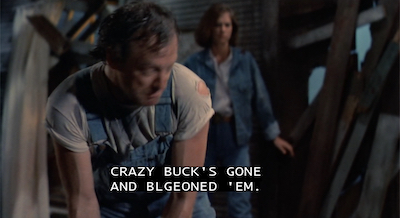 Raimi wrote the sequel with his childhood friend and Super-8 collaborator Scott Spiegel, who was also working on their buddy Josh Becker’s THOU SHALT NOT KILL… EXCEPT, co-starring Raimi. (Spiegel would go on to direct the grocery store slasher INTRUDER and notable DTV films FROM DUSK TILL DAWN 2: TEXAS BLOOD MONEY, MY NAME IS MODESTY and HOSTEL: PART III.) At the time, Raimi and Spiegel were living in Silver Lake with the Coen Brothers, Frances McDormand, Kathy Bates and Holly Hunter (who they’d wanted to play Bobbie Joe). I believe there’s a nod to the Coens when Jake says “If you ask me, crazy buck’s gone blood simple,” though the DVD subtitles disagree that that’s what he says.
Raimi wrote the sequel with his childhood friend and Super-8 collaborator Scott Spiegel, who was also working on their buddy Josh Becker’s THOU SHALT NOT KILL… EXCEPT, co-starring Raimi. (Spiegel would go on to direct the grocery store slasher INTRUDER and notable DTV films FROM DUSK TILL DAWN 2: TEXAS BLOOD MONEY, MY NAME IS MODESTY and HOSTEL: PART III.) At the time, Raimi and Spiegel were living in Silver Lake with the Coen Brothers, Frances McDormand, Kathy Bates and Holly Hunter (who they’d wanted to play Bobbie Joe). I believe there’s a nod to the Coens when Jake says “If you ask me, crazy buck’s gone blood simple,” though the DVD subtitles disagree that that’s what he says.
They filmed in some woods and a middle school gym in Wadesboro, North Carolina, with the barn from THE COLOR PURPLE as their production office. Part I’s special effects maestro Tom Sullivan felt this one was a little too big for him to take on by himself, so he worked on stop motion and props and Mark Shostrom (A NIGHTMARE ON ELM STREET 2, FROM BEYOND) was brought on to do makeup.
The first film’s director of photography Tim Philo also felt underqualified and turned down the gig, though he ended up doing second unit, including some of the evil force shots he’d pioneered before and some effects shots done in a warehouse in Michigan. For the main shoot they hired Eugene Schlugleit, who had done the CRIMEWAVE reshoots, but he and his crew rebelled against the complicated work and were fired after only shooting the night exteriors. The rest was done by newcomer Peter Deming.
The finished film was considered so violent at the time that it could not possibly be cut to an R-rating. That nice “Rosebud Releasing Corporation” logo at the beginning is a made up shell company so De Laurentiis could released it unrated despite being a signatory to the MPAA. When it was released on Friday the 13th of March, 1987 it was only on 310 screens, so it could hardly make much cash. It opened against the Burt Reynolds movie HEAT, which was on 863 screens. Its horror competition included A NIGHTMARE ON ELM STREET 3: DREAM WARRIORS (1,365 screens), ANGEL HEART (819 screens) and WITCHBOARD (1,068 screens).
But despite whatever disreputableness its unrated status might’ve implied, it was well reviewed, including by Siskel & Ebert. I remember that because when I saw THE EVIL DEAD as a middle school doofus I was too young to appreciate it, and thought it was bad. And then at the video store I noticed the critic’s quotes on the cover of EVIL DEAD 2, including
“Very clever and very funny.” —SISKEL & EBERT & THE MOVIES
What? How could that be? They liked the sequel to that movie? That was the specific reason I rented it, and it blew me away. I particularly remember the time travel ending being a big, thrilling shock, so I’ve always felt a little bad for the younger generations who can only experience it already knowing what its sequel is about.
But even when it’s not a surprise at all, even now that I’ve seen it dozens of times, it’s a blast every time. Few movies are such pure, unadulterated entertainment – fun and funny, fast moving, stylish, original. It never lets up, but never gets tiring, ending so quickly but not a moment too soon. Every piece of it feels like they know exactly what they’re doing and yet also that they pushed way beyond the limits of what they were supposed to be able to do. Lovingly hand-crafted by a group of friends with big smiles on their faces, who also happen to be extremely talented and eager to prove themselves and/or unwilling to skimp on anything. It’s a certified Great Fucking Movie.
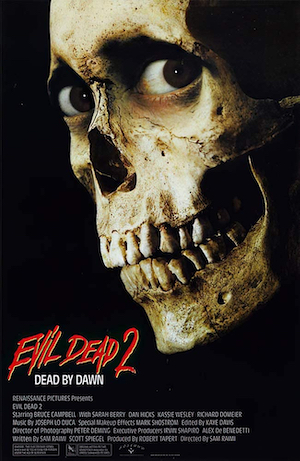 It also turned out to be a springboard for numerous high profile careers. Rookie cinematographer Peter Deming’s later films include HOLLYWOOD SHUFFLE, HOUSE PARTY, LOST HIGHWAY, MULHOLLAND DRIVE, I HEART HUCKABEES, SCREAM 2, 3 and 4 and CAPONE. Makeup artists Robert Kurtzman, Greg Nicotero and Howard Berger soon formed KNB EFX group, providing gore for INTRUDER, NIGHTMARE ON ELM STREET 5 and HALLOWEEN 5, plus DANCES WITH WOLVES, MISERY, CITY SLICKERS, and Tarantino’s movies. These days (minus Kurtzman) they are the most prolific zombie makers of all time, having done all of the Walking Dead shows. EVIL DEAD II was also one of the first credits for sculptor Steve Wang, who would go on to become a great makeup effects artist as well as director of THE GUYVER, KUNG FU RASCALS, GUYVER: DARK HERO and DRIVE. Another sculptor, Tony Gardner, was a few years into his career, but a year later he did the incredible effects for the remake of THE BLOB. Even the “additional synthesized sound effects” creator went on to do more great work – Drew Neumann was the brilliant soundtrack composer and sound designer for the one-of-a-kind animated series Aeon Flux.
It also turned out to be a springboard for numerous high profile careers. Rookie cinematographer Peter Deming’s later films include HOLLYWOOD SHUFFLE, HOUSE PARTY, LOST HIGHWAY, MULHOLLAND DRIVE, I HEART HUCKABEES, SCREAM 2, 3 and 4 and CAPONE. Makeup artists Robert Kurtzman, Greg Nicotero and Howard Berger soon formed KNB EFX group, providing gore for INTRUDER, NIGHTMARE ON ELM STREET 5 and HALLOWEEN 5, plus DANCES WITH WOLVES, MISERY, CITY SLICKERS, and Tarantino’s movies. These days (minus Kurtzman) they are the most prolific zombie makers of all time, having done all of the Walking Dead shows. EVIL DEAD II was also one of the first credits for sculptor Steve Wang, who would go on to become a great makeup effects artist as well as director of THE GUYVER, KUNG FU RASCALS, GUYVER: DARK HERO and DRIVE. Another sculptor, Tony Gardner, was a few years into his career, but a year later he did the incredible effects for the remake of THE BLOB. Even the “additional synthesized sound effects” creator went on to do more great work – Drew Neumann was the brilliant soundtrack composer and sound designer for the one-of-a-kind animated series Aeon Flux.
And for Raimi it undid the curse of CRIMEWAVE and helped him break into bigger Hollywood films. Campbell saw the writing on the wall that his buddy was gonna start getting offers for big movies that (like with CRIMEWAVE) he wouldn’t be able to star in, so he decided to leave their production partnership and pursue acting opportunities on his own. He soon found work on an episode of Knot’s Landing and in MANIAC COP, MOONTRAP, INTRUDER and SUNDOWN: THE VAMPIRE IN RETREAT. Meanwhile, Raimi sold Universal Studios a treatment about “a man who can change his face”…
The post Evil Dead II first appeared on VERN'S REVIEWS on the FILMS of CINEMA.

